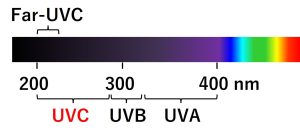PRODUCT

A patent application is currently pending for this system (patent application no. 2025-063854).
Factors leading to the surge in fish disease outbreaks
〇
〇
〇
〇

WHAT IS FAR-UVC?
Far-UVC is ultraviolet light with a wavelength of 200–230 nm. The 222 nm wavelength in particular has the same high sterilizing effect as conventional sterilizing ultraviolet light (UVC, 254 nm, etc.), but is easily absorbed by proteins on the surface of the skin and eyes of living organisms and does not easily reach the nucleus (DNA) of cells, so it is considered to have an extremely small effect on the human body.
Pathogenic microorganisms (such as bacteria and viruses) are so small that Far-UVC can damage and inactivate genes (DNA and RNA) in the cell nucleus. Our Far-UVC system utilizes this capability to safely and effectively eliminate pathogens in aquaculture environments.

Far-UVC is ultraviolet light with an extremely limited wavelength range of 207 to 222 nm (mainly 222 nm).

Applications of ultraviolet light by wavelength


Aquaculture application benefits
〇
〇
〇
〇
〇
〇
〇
BEAMCURE | Conventional UVC | Ozone | Chemicals | Biotics | |
Features | • Gentle on the human body • Has antibacterial properties | • Strong bactericidal effect | • Gas • Strong oxidizing effect • Effective for sterilization and deodorization | • Alcohol • Sodium hypochlorite • Hydrogen peroxide and many more | • Utilizing microorganisms • Suppression of harmful bacteria • Health promotion |
Seafood Safety | ✓ | ✓ | ✓ | ||
Inactivation of pathogens | ✓ | ✓ | ✓ | ✓ | |
Cost | ✓ | ✓ | ✓ | ✓ |
It is finally possible to expose aquariums where seafood grows to UV rays!
Conventional UV irradiation can have a detrimental effect on fish and shellfish, so it is necessary to temporarily move the fish and shellfish from the tank to another location.
This requires a lot of time and effort, and inevitably leads to reduced work efficiency and stress for the fish and shellfish.
However, our innovative technology has made it possible to safely irradiate UV rays to fish and shellfish while they are still growing.
This makes aquarium hygiene management easier and more efficient than ever before, and significantly shortens the work process and reduces costs.

Safety certifications and academic evidence
As a joint research project with Tokyo University of Marine Science and Technology, we conducted irradiation tests in Thailand to preserve the quality of vannamei shrimp (August to December 2024).

- 〇
Prevent deterioration of water quality
- 〇
Inhibits the growth of microorganisms
- 〇
Suppresses the growth of biofilms

- 〇
Suppresses bacterial growth in aquaculture water by up to 99.7%
- 〇
Inhibits bacterial growth on shrimp surfaces by up to 99.8%
DATA SERVICES
Our data service, BEAMCURE, is a comprehensive solution that maximizes the benefits of installing Far-UVC irradiation systems and achieves more advanced aquaculture management (we plan to start offering the following services in due course).
- 〇
Real-time monitoring: The operating status of the Far-UVC irradiation system (irradiation time, intensity, etc.) is monitored in real time, and an alert is sent if an abnormality is detected.
- 〇
Water quality data integration: Links with water quality sensors such as water temperature, pH, and dissolved oxygen to analyze correlations with the effects of Far-UVC irradiation.
- 〇
Fish data analysis: Fish growth data (weight, body length, etc.) and food intake data will be collected and analyzed to evaluate the effects of Far-UVC irradiation on growth and appetite.
- 〇
Medical history data management: Past fish disease occurrence histories and treatment records are centrally managed and used to predict future fish disease risks.
- 〇
Optimization suggestions based on AI: By utilizing accumulated data and AI algorithms, we suggest optimal Far-UVC irradiation conditions, early detection of signs of fish disease, efficient feeding management, and more.
- 〇
Report function: Through regular reports, we will clearly inform you of the status of the farm and areas for improvement.
- 〇
Remote support: Provide experts with remote troubleshooting and operational support through data.
By using BEAMCURE, fish farmers can make decisions based on scientific data rather than relying on intuition and experience, resulting in more stable production and improved profits.

